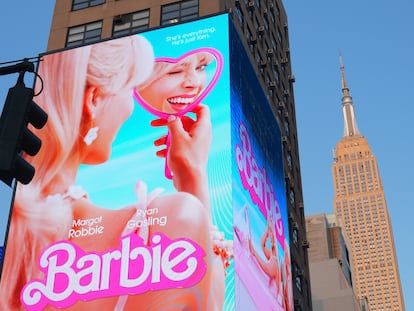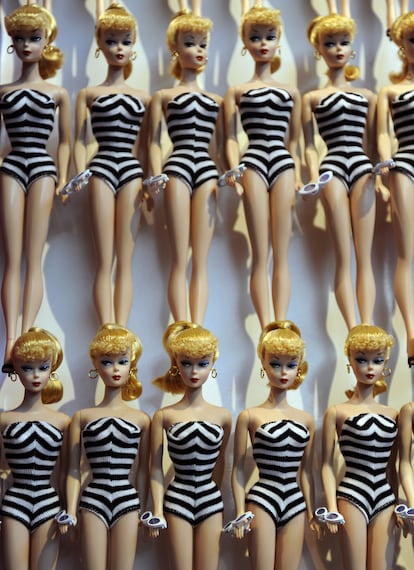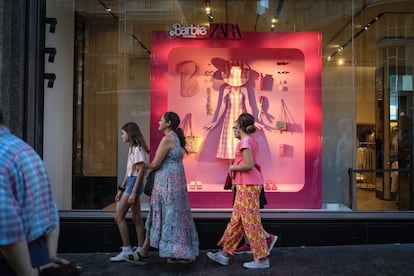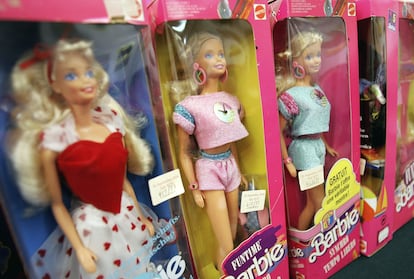Pink is political: How ‘Barbie’ blends activism, entertainment, and business as usual
Greta Gerwig’s feminist fantasy-comedy is taking the box office by storm, but the film’s success is also its politics, which go only so far as the Mattel corporation will allow: ‘A movie that ridiculed Barbie would have been disastrous for the brand’

For some time now, and until further notice, pink means Barbie, whether it’s really about Barbie or not. Ever since the movie about Mattel’s most iconic toy doll began its impressive advertising campaign, the world has been flooded in waves of pink — a tide that has managed to swamp more than just the land of cinema. In the span of merely a few months, we have witnessed the #Barbiecore trend on Tik-Tok, with users creating their own Barbie-inspired outfits and pink-themed aesthetics, and pink-carpet photoshoots taking place around the world with celebrities ransacking the vintage archives of major fashion houses to dress in the spirit of the famous doll. Scores of adoring fans have dug up their most chic and beloved garments from childhood — pink outfits abandoned in adolescence and rediscovered thanks to Barbie — eagerly consuming the advertisements and products launched by Mattel and collaborators, like Barbie lipstick and Ken underwear. And on top of all the pop culture hullabaloo, Barbie has entered the world of politics too: while the right criticizes her for promoting a “woke agenda,” liberals and leftists like Spain’s Second Deputy Prime Minister Yolanda Díaz are flocking to the film and sharing their enthusiasm for Barbie’s feminist agenda on social media.
“Colors are fundamental in marketing and advertising because they’re a very powerful tool for conveying emotions and improving brand recognition,” explains Bego Romero, a digital marketing consultant whose personal website also features pink as the dominant color. “Pink is associated with femininity, sweetness, softness, delicacy, but it’s also true that now, thanks to an excellent marketing campaign that has made the brand very memorable, the image of Barbie pink has emerged, which we immediately associate with the doll. When someone says ‘I bought a Barbie-pink bag’ and you immediately know exactly which tone it is, it speaks to this very strong brand identity, which also expresses an emotional connection: the color will always remind us of childhood,” she says.
Protected by its semantic field of softness and childishness, cushioning its connotations, Barbie pink is also an intense, vibrant and striking color that suggests vitality and passion, and that somehow has become — thanks to the doll, which has always reflected the socio-cultural trends of the time — a signifier of feminine character and strength, a banner of girlboss feminism and, in corporate contexts, a sign of the commitment of brands to liberal progress and social justice. This perception, which implies a tension between continuity (of gender roles, for example) and subversion is also found within, and in the very concept of, Barbie the movie.

Speaking to The New Yorker’s Alex Barasch, Greta Gerwig described the sensation of entering Mattel’s headquarters for the first time: It was like the company had shattered, at least cosmetically, her mental image of what a corporation should be (instead of dull and gray, everything was “bright pink” and “very cinematic,” she said). And indeed, many of today’s films and cultural products are now manufactured under a new corporate logic and aesthetic that is more chic and feminine — two qualities practically imprinted on Barbie’s DNA.
Pink invites subversion and the breaking of certain corporate conventions, and perhaps even the exploration of excluded identities or inhibitions. But what does this get us, other than a parallel corporate world in pink? “In this sense, Barbie the film is nothing more than a way to revitalize Barbie the doll, to make a marketing niche for her in the post-MeToo liberal feminist world,” argues Pablo Caldera, a Spanish cultural critic. “That other companies, like [fashion retailer] Zara, would take advantage of these same cultural codes seems, to me, a natural step. The film itself inhabits this same world of extreme corporatism, erasing or neutralizing any potential power it might have had to inspire spontaneous or collective forms of association.”
The pink flood that is sweeping so many of us up is propelled by two main driving forces: nostalgia and virality. Mattel CEO Ynon Kreitz’s stated goal, for the medium term, is to transform the company from a toy manufacturer into a franchise management company — a “pop culture” company. In addition to Barbie, Mattel has announced fourteen other films (Lena Dunham is working on Polly Pocket; J.J. Abrams on Hot Wheels) and 45 more are in “development.” In today’s Hollywood of endless franchises, more and more companies want to play; it’s no longer about making toys and spin-offs from popular movies, but about making movies about pre-existing products. This year alone, we had Ben Affleck’s Air, about the Air Jordan basketball shoe line, and Eva Longoria’s Flamin’ Hot, the origin story of Spicy Cheetos. “People are always going to trust and be drawn to things they’re familiar with,” Romero explains. “What they’re doing with Barbie, and what Hollywood does in general, is playing with people’s emotions: if a consumer has had a good relationship or meaningful experience with a brand, it’s going to be easier for them to want to consume a new version of that same product.”
The Barbie brand is not the first to transcend the realm of cinema and become a world unto itself, but unlike other cult films, where the collective experience becomes more important than the film itself (such as the 1978 The Rocky Horror Picture Show, where theater-goers go to sing and throw popcorn), Barbie’s popularity preceded the film. In the case of Mean Girls (2004), fans also wore pink (a pink that, incidentally, served to point out the dangers of confusing substance with form; the hypocrisy of the film’s worst protagonists dressed in the sweetest of colors). But in the case of Barbie, fans wear pink to signal our membership in the marketing campaign; what mobilizes us to dress in uniform is the decades-long work of building a magnetic brand identity. It’s popular culture, but a completely manufactured one.

“On the one hand, it seems like a positive development that we’re returning to the question of cinema as a social phenomenon that requires codes of intelligibility that are relatively transparent,” Caldera says. “But it’s also true that something as seemingly benign and casual as the leaking of photos from the film’s shooting, the successive trailers promoting the release, and the exploitation of memes, which are an inherently collective force, are all the result of an extreme form of corporatism, with Marvel being the only other parallel.” For Romero, Barbie’s marketing campaign is one of the best he has seen in recent years: “They’ve managed to combine absolutely everything,” she said.
Barbie’s maximalism permeates both its forms and objectives. From its early stages of conception, the film was conceived as something that would please everyone (or as many people as possible): “If you love Barbie… if you hate Barbie, this movie is for you,” is one of the advertising slogans. This is made all the more evident by the fact that Barbie’s character arc is ultimately less important than Ken’s. The film may have become a social phenomenon, but at its core, it has always and above all been an advertising phenomenon — something that necessarily had to result from compromises between the creative team and Mattel’s corporate representatives. “It’s very interesting, and something you notice when watching the film, because you can clearly see the limits that have been set by the corporation,” Caldera says. “In the beginning, the film plays around with subverting its own origins (‘feminism’ and ‘Mattel’ are mentioned within the first few minutes), but it’s all part of a directed and ultimately homogeneous production. Not taking full advantage of Will Ferrell’s character [a Mattel executive] can only be explained by the film’s own lack of creative and political autonomy from the corporate franchise. It’s as if they were only allowed certain themes, certain jokes, and were prohibited from going too far, from making it into a parody.”

Indeed, Mattel’s CEO has admitted as much, explaining that if the movie had ridiculed Barbie, it would have been disastrous for the brand. “Barbie is aspirational, inspirational — not something you want turned into a parody,” Kreiz told The New Yorker. This is why the company — which in 1997 went so far as to sue M.C.A. Records over Aqua’s song “Barbie Girl,” which nevertheless appears in the film’s trailer — scrapped an earlier proposal for a Barbie movie starring comedian Amy Schumer. The corporation didn’t want satire: “I think the film goes for a soft critique, which is always welcome and necessary, but ultimately it ends up reinforcing the power and updating the image of the company behind it,” Caldera argues.
In the movie, and despite some initial protests from Mattel’s executives, Gerwig plucks certain failed moments out of the dustbin of the doll’s history, to show that Barbie is not some rigid, conservative monolith, but a fluid and constantly changing signifier. Perhaps, however, in this process of showing, there is also an element of erasure. Hollywood knows that gentle satire is the best way to whitewash (or, should we say, pinkwash) certain trends in cinema with obvious corporate ends, and the implications go well beyond Barbie. Gerwig herself has stated several times that her aspiration is not to become the best director in the world, but to be a great studio director.
“I think this film will put an end to Gerwig’s reputation in independent cinema,” says Caldera, who also points to another crucial issue: “The coincidence of the film’s release with Hollywood’s actors and screenwriters going on strike seems to me a historic opportunity to think collectively about this particular mode of production, which distracts the viewer’s attention and has dominated the discourse from the moment the premiere was announced. It’s not even a spectacle anymore, I don’t think there is even any collective pleasure, just the need to give a nod to the revitalization of certain discourses that we thought we had forgotten. In that sense, Barbie is as nostalgic as any other blockbuster released in 2023, unfortunately. The insistence on generational transference in the film leads to this neutralizing of more radical discourses.”

History in pink
A very important and often forgotten feature of the color pink, explained by Lynn Peril in her book Pink Think: Becoming a Woman in Many Uneasy Lessons, is its power of concealment. While it is often said that pink has always been associated with femininity — and despite the amusing coincidence that the first cultural phenomenon to draw a clear relationship between pink and being a girl was Louisa May Alcott’s 1869 novel Little Women, which Gerwig adapted to film in 2019 — the truth is that it was not until the end of World War II that the color became popular among American women as a sign of returning to a lost domesticity. It was during this era that the first lady of the United States, Mamie Eisenhower, would adopt pink as her signature color, to convey the message that women could hang up their factory overalls, return to the home, and resume their traditional role.
With Mrs. Eisenhower as its model, the marketing industry began filling American homes with pink. Later, the actress Jayne Mansfield would take the trend to ultimate heights, building a pink palace with a pink Jacuzzi, getting married in a pink wedding dress, dying her dogs pink, and thoroughly consolidating the association between the color and notions of innocuous, obedient femininity. The truth, however, is that even Mansfield herself did not have a genuine connection with pink: she chose the color because she needed a brand of her own, and because she knew it would make her less threatening to her male competitors. The color soon revealed itself as a tool — a way, for example, of appearing more innocent than one truly was. Perhaps this is why pink is now the color of pop culture, and also a tool for filmmakers, like John Waters or Kenneth Anger, who want to subvert the color’s connotations and point to its hidden meanings. In cinema, too, a somewhat darker, more perverse and more interesting story can be drawn from the color pink — the color that hides as much as it shows.
Today, Barbie is washing everything in pink, from social media to store windows, and more than 100 brands are now involved in the production of various absurd, Barbie-themed objects. In Los Angeles, pink Barbie benches have appeared overnight, complete with built-in anti-sleeping dividers to prevent the city’s homeless from using them to rest. Recently, someone on Twitter summed up the situation succinctly: “Heart-warming: this hostile architecture is pink.”
Sign up for our weekly newsletter to get more English-language news coverage from EL PAÍS USA Edition
Tu suscripción se está usando en otro dispositivo
¿Quieres añadir otro usuario a tu suscripción?
Si continúas leyendo en este dispositivo, no se podrá leer en el otro.
FlechaTu suscripción se está usando en otro dispositivo y solo puedes acceder a EL PAÍS desde un dispositivo a la vez.
Si quieres compartir tu cuenta, cambia tu suscripción a la modalidad Premium, así podrás añadir otro usuario. Cada uno accederá con su propia cuenta de email, lo que os permitirá personalizar vuestra experiencia en EL PAÍS.
¿Tienes una suscripción de empresa? Accede aquí para contratar más cuentas.
En el caso de no saber quién está usando tu cuenta, te recomendamos cambiar tu contraseña aquí.
Si decides continuar compartiendo tu cuenta, este mensaje se mostrará en tu dispositivo y en el de la otra persona que está usando tu cuenta de forma indefinida, afectando a tu experiencia de lectura. Puedes consultar aquí los términos y condiciones de la suscripción digital.
More information
Archived In
Últimas noticias
There is as much life left to discover on planet Earth as that which is already known
Dozens presumed dead, around 100 injured in fire at Swiss Alps bar during New Year’s celebration
Is porn for women different from conventional porn? We spoke to those who make it
Cartagena de Indias is sinking: What can the city do to mitigate it?
Most viewed
- Reinhard Genzel, Nobel laureate in physics: ‘One-minute videos will never give you the truth’
- Sinaloa Cartel war is taking its toll on Los Chapitos
- David King, chemist: ‘There are scientists studying how to cool the planet; nobody should stop these experiments from happening’
- Oona Chaplin: ‘I told James Cameron that I was living in a treehouse and starting a permaculture project with a friend’
- The Interoceanic Train, the Mexican alternative to the Panama Canal










































